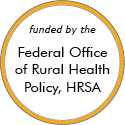Rural Project Examples: Critical Access Hospitals
Other Project Examples
Indiana Statewide Rural Health Network (InSRHN)

Updated/reviewed July 2023
- Need: To improve sustainability and financial viability for rural healthcare providers throughout Indiana.
- Intervention: A network of rural healthcare providers for Critical Access and other hospitals in Indiana that are dedicated to improving their ability to deliver efficient and high-quality healthcare for their rural residents.
- Results: The network has been leveraged to increase access to resources, coordinate services, and improve and expand healthcare access.
Jefferson Healthcare Prescription CSA
Added July 2023
- Need: To increase food security among low-income patients living with cancer and diabetes in rural Jefferson County, Washington.
- Intervention: A local healthcare system partnered with a small organic farm to offer weekly produce boxes to eligible low-income patients.
- Results: 10 patients participated in the Jefferson Healthcare prescription CSA program in 2022. In 2023, the program grew to serve 15 patients.
The Minnesota Integrative Behavioral Health Program
Updated/reviewed May 2023
- Need: Out of 79 Critical Access Hospitals (CAHs) surveyed in Minnesota in 2015, behavioral health was the most frequently cited service requested.
- Intervention: In response, Rural Health Innovations launched the Minnesota Integrative Behavioral Health Program. This initiative engaged representatives across all sectors in health integration between hospital, primary care, and community services.
- Results: Strategy sessions resulted in the creation of resource directories to improve care coordination, evaluation measurements to document results, and an overall better understanding of integrative care challenges.
Boone County Health Center Pulmonary Rehabilitation Program
Updated/reviewed June 2022
- Need: Evidenced-based intervention to improve function and quality of life for patients with chronic obstructive pulmonary disease and other chronic lower respiratory conditions.
- Intervention: Pulmonary rehabilitation program implementation in 1989.
- Results: Compared to a national average of only about 3% of referred Medicare beneficiaries actually enrolling in pulmonary rehabilitation, 60% of the program's referred patients enroll. Averaging around 15 patients/year completing the program, a large combined cardiac and pulmonary rehabilitation maintenance population averages 8,000 visits/year.
Avita Health System Comprehensive Cardiology Program
Added April 2021
- Need: Population health approach to decreasing area deaths from cardiovascular disease.
- Intervention: A health system-level investment in level II cardiac catheterization services and the required specialized cardiology workforce.
- Results: Since August 2018, the Avita Health System in north central Ohio has provided local cardiovascular services that have decreased hospital transfers, increased care coordination, and provided education and prevention activities that, with time, will impact population health cardiovascular outcomes.
Southwest Health System Antibiotic Stewardship Program
Updated/reviewed March 2021
- Need: Impact patient care and safety issues related to antibiotic use in southwest Colorado.
- Intervention: Pharmacy-led antibiotic stewardship program for inpatient, outpatient, and long-term care settings.
- Results: With antibiotic use guidelines, refined infection diagnostics, and first-choice antibiotic selections, all care settings now see decreased days of treatment and decreased resistance patterns.
Medical Home Plus

Updated/reviewed February 2020
- Need: To help reduce diabetes, depression, and stroke risk in rural residents.
- Intervention: A collaborative care model was implemented in the Idaho counties of Clearwater, Idaho, and Lewis.
- Results: Increased number of patients with controlled blood sugar, controlled blood pressure, and higher depression screening rates.
For examples from other sources, see:
